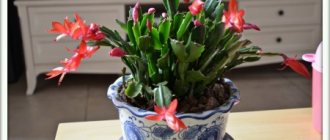This forest cactus called Decembrist has other names:
Dear readers! For you, we have created communities on social networks in which useful articles and interesting ideas are published several times a day! Subscribe and receive useful content in a convenient format!
- Christmas cactus:
- Schlumberger;
- Zygocactus.
Since this is a forest cactus, if we replant it according to all the rules and on time, we will get a beautifully flowering bush.
How to determine if a flower needs replanting
The most important reason is replanting the flower after purchase - this is especially true for those specimens that come from Holland. They are grown in peat, which is not suitable for permanent cultivation and is only suitable for greenhouse conditions. Therefore, the flower is transplanted into properly selected soil. If you do not replant the leaves, the segments will become depleted and wither, which will lead to the death of the flower.- The root system of the flower peeks out from the drainage holes of the container - this indicates that the plant has completely mastered the container in which it lives and requires a planned transplant into a new pot of a slightly larger diameter.
When to replant a Decembrist flower
After acquisition, the question often arises of when to replant Decembrist at home. It is better to postpone the action until the end of February, when the length of daylight and the intensity of sunlight naturally increases. At this time, active growth of the bush will begin; it is determined by new segments appearing at the ends of the branches. During the active growth of a houseplant, sap flow increases and the replanting of the Decembrist plant will be carried out without loss by a novice gardener who has made small mistakes.
Decembrist in a pot photo
Important! Over the summer, the Decembrist will grow new leaf segments and begin to prepare for winter flowering. Buds appear at the ends of new leaves. The question that has arisen about when to replant the Decembrist plant is clearly answered in late winter and early spring.
How to replant after purchase
After purchasing, the flower must be replanted, completely getting rid of the peat. To do this, you need to carry out the necessary steps:
- Remove the flower from the transport pot:
- Remove peat completely;
- If it does not separate, it can be removed using a toothbrush, gently combing the roots in the direction from the root collar to the ends of the roots;
- After which the flower is inspected for the presence of pests and planted in new specialized soil.
Important! After purchase, the plant must be quarantined for about 2 weeks to determine whether it is infected or not with various pests.
Lighting
Zygocactus needs a sufficient amount of light, but not bright and diffused. Direct sunlight can damage the delicate leaves of the flower. In spring and summer, when the sun is especially active, the Decembrist should be artificially shaded.
During flowering, zygocactus is especially sensitive to light. The wayward plant does not like when its position relative to the sun changes abruptly. Experienced flower growers advise moving the Decembrist plant as little as possible. Otherwise, he may react by dropping the buds ahead of time. Often the same reaction can be observed if you touch the flowers with your fingers.
Which pot to transplant into?
The right pot is half the battle to stimulate Decembrist flowering.
Since in a pot that is too large and spacious, the flower will grow the root system until it fills the entire space of the pot. There will be no flowering at this time.
At the same time, the roots of the Decembrist are located almost on the surface, so not a deep, but a wide pot will suit him.
Important! It is also necessary to have drainage holes through which irrigation can be carried out using the immersion method, and excess water will be drained after watering.
Decembrist, plant description and photo
The Decembrist came to us from Brazil, where there are humid forests that promote its growth and reproduction. This plant has 17 names, one of them is Schlumberger or Zygocactus.
This flower is also considered a type of cactus, but the difference is that it does not have the spines that are so characteristic of this family.
Characteristic:
- Decembrist branches are green, flattened and hang neatly.
- The inflorescences are arranged in tiers and have the following colors: cream, lavender, raspberry, red, orange, pink.
The peculiarity of the Christmas tree is that it blooms when other plants are in the dormant stage.
The root system is weak and fragile, but the roots quickly recover and strengthen after damage.
If you provide proper care, this indoor plant will not cause much problems or hassle.
What soil to replant in?
The soil can be purchased ready-made labeled “For cacti.” If you don’t have it, you can make it yourself by taking all the ingredients in equal proportions:
- Leaf soil - collected under trees in the forest away from roads;
- Turf land;
- Sand;
- ¼ part of humus.
You can also add a little soil “For Orchids” to this composed soil, which contains coal and bark. The soil should be nutritious and loose. And as it settles in the pot, it is added to the required level.
Soil made on your own requires sterilization. To do this, it is steamed for 20 minutes in the oven at 200 degrees. Or you can put it in the freezer of the refrigerator for a day.
Important! The soil must be loose, as this is an epiphytic plant.
Soil disinfection
How to transplant cyclamen at home correctly
Self-prepared soil requires disinfection and sterilization. For disinfection, crushed coal is added to the soil. There are two ways to sterilize soil:
- heating in the oven at 200 degrees for half an hour;
- cooling in the freezer for 24 hours.
Preparing for transplant
The pot and soil have been purchased, all that remains is to prepare the flower itself for replanting. First of all, the Decembrist needs to be put in order: manually remove excess leaf segments to give the plant a more attractive appearance. Removing excess segments will make it possible to form a lush bush, which in the future will delight with abundant flowering. After this procedure, the “Christmas” cactus should be thoroughly wiped with a small brush and rinsed under running warm water.
It is advisable to disinfect the place where the Decembrist grows in order to destroy pests and prevent possible diseases.
Now everything is ready to transplant the flower!
Step-by-step instructions for transplanting Decembrist
For a beginner who is replanting a plant for the first time, it is best to adhere to all the replanting rules given below. Otherwise, violations and errors can lead to the death of the plant.
Basic requirements for plant transplantation:
- First, you should purchase a pot of the required shape and size. The shape of the container should be such that the width exceeds the height of the pot. The size needed is slightly larger than the previous pot so that the flower begins to bloom in the first winter. If you take the pot to grow, the plant will take a long time to grow its root system and will not bloom.
- We purchase the necessary soil or make it ourselves.
- At the bottom of the planting container we place a 2 cm layer of drainage and a little soil.
- We take the Decembrist out of the old pot and carefully shake off its roots so that the excess soil is sprinkled.
- After that, holding it with your hands, transfer it to a new pot and place it on the ground in the center of the container.
- Holding the flower with your left hand, pour fresh specialized soil around the root system of the plant with your right.
- When filling the pot with soil, there is no need to press it down. After watering, some of it will shrink, and then it will be necessary to fill it up to the required level.
Important! The first watering is carried out only on the third day. However, it should be produced with warm water and not in large quantities. And for the first two weeks it is better to spray the flower with warm water.
How to choose a pot and soil
Before transplanting, it is important to decide which pot is needed for the Decembrist flower. Due to the plant’s pickiness, the container can be made of almost any material.
How to replant Kalanchoe - what soil and pot are needed
Experienced gardeners recommend using the following types of pots:
- ceramic (any plant will gratefully respond to natural material);
- clay (a huge variety of pots made of clay will not leave anyone indifferent);
- glass (new - pots made of glass allow you to monitor the condition of the root system);
- wooden boxes (most often used for growing a large number of flowers at the same time);
- plastic vases (a good alternative cheap material with a wide range of shapes and colors).
Remember! The use of metal can lead to corrosion if it is in constant contact with wet soil. As a result, rotting of the root system and death of the flower.
To replant this particular plant, experts advise purchasing soil intended for succulents and cacti. Alternatively, you can make the soil mixture yourself.
To prepare a suitable substrate you need to take:
- 2 parts sifted sand;
- 1 part leaf soil;
- 1 part peat or moss;
- 1 part expanded clay.
Advice! For cacti, it is recommended to use rocky but light soil.
Soil disinfection
To destroy pests and possible fungi, the soil must first be disinfected. The procedure can be carried out in several ways:
- watering the soil in advance with a weak solution of potassium permanganate;
- calcination of the earth at elevated temperatures, for example, in an oven;
- preliminary spilling of the substrate with the Baikal preparation.
Attention! Experienced flower growers advise treating not only the soil and the plant, but also its future location.
How to plant Decembrist
This flower is quite easy to propagate. Even a novice gardener can do this. To do this, it is enough after flowering, when new growth of segments begins, to unscrew the cuttings with 2-3 adult segments clockwise and use them to propagate the plant. Also, such cuttings are formed after annual pruning, which is carried out after flowering.
There are two ways to germinate roots from cuttings:
- In water.
- In the ground.
Reproduction of Decembrist in water
The cuttings are unscrewed and placed in water to grow roots. In this case, only the lowest petiole is immersed in water, not forgetting to dry it for 3 hours after unscrewing. If the water becomes cloudy the next day, it is poured out and the cuttings are washed under running water.
After this, a tablet of activated carbon is added to the new water, and the cutting is placed again to build up the root mass.
Reproduction of the Decembrist in the ground
The cuttings are unscrewed and dried.
After this, take small containers filled with specialized soil. In the center, make a 2-3 cm depression with your finger or a pencil and plant the cuttings, deepening them by 1/3 of the segment.
If the room has good humidity and warmth, there is no need to cover the cuttings with anything. But if the room is very hot and dry, then it is worth covering such cuttings with a glass jar, but daily ventilation will be necessary. Because without them, a fungus can develop on the cutting from excess greenhouse humidity, which will lead to the death of the cutting.
Preparing for transplant
Preparing a zygocactus for transplantation includes several stages: choosing a container, cultivating the soil and the plant itself. It is important to take care of all this in advance to ensure the most comfortable conditions for the flower. To do this, you need to first familiarize yourself with its requirements for the pot and soil. Let's look at each point in more detail.
Choosing a pot
The container in which the Christmas tree will grow is an important component of its growth and development. For the Decembrist, the ideal container would be a not very high and deep pot, since the root system of the flower is located superficially and does not reach the bottom. At the same time, a pot that is too spacious will provoke an intensive growth of roots and green mass of the zygocactus, which will interfere with the formation and development of buds and will result in a lack of flowering.
Did you know? In its natural habitat, Schlumbergera is pollinated by the smallest birds on the planet
-
hummingbird.
If you transplant the plant into a container that is too deep, this will lead to stagnation of water at the bottom and subsequently to waterlogging of the soil. The best option is to choose a flowerpot that is only 2–3 cm larger than the previous one, and the material from which it is made does not play a special role. The most important thing is that there is at least 1 drainage hole at the bottom of the pot.
Soil preparation
- Zygocactus also has its own preferences regarding soil:
- the soil must be loose and well permeable to water;
- the soil should be slightly acidic - the acidity level pH should not exceed 6.0;
- the soil must be saturated with organic matter.
In agricultural stores today there is a huge selection of ready-made soil mixtures. The most optimal option would be the one labeled “For cacti.” It is recommended to have various large inclusions in the soil - these could be brick chips, sand or pieces of coal. As a rule, the most suitable nutrient mixture for the Decembrist is turf soil.
Important! At first, it is necessary to water the zygocactus only on moist soil, so as not to expose the plant to even greater stress.
To disinfect the soil, crushed coal must be added to it, and expanded clay must be added to increase impermeability. However, you can also make the soil yourself by selecting the necessary ingredients.
The ideal composition for Christmas is as follows:
- turf soil - 5 parts;
- humus - 3 parts;
- leaf soil - 2 parts;
- peat - 2 parts;
- crushed coal - 20%;
- brick chips - 20%.
Before planting a plant in a pot, it is necessary to create a layer of expanded clay drainage at its bottom, occupying 1/4 of the height of the container. Subsequently, this will facilitate further care of the Decembrist and protect its roots from rotting.
Flower processing
Before transplanting the Christmas tree to a new place, you should take care of its appearance - put the bush in order, thoroughly wash and wipe it. First you need to trim the plant to give the bush a more attractive shape. However, it is important not to cut off excess sections on the shoots, but to unscrew them manually. This will allow you to form a more lush and profusely flowering bush with healthy large flowers.
Care after transplant
After transplanting a flower, it is necessary to organize conditions that are comfortable for it, which are close to those in its homeland:
- The air temperature for the Decembrist should be within 16-18 degrees in winter, and in summer he prefers temperature limits of 23-26 degrees Celsius.
- Humidity should be average. The flower will have nothing against spraying with warm water once a week in the summer.
- Direct sunlight in the summer may well destroy the plant; it prefers partial shade in the summer and walking in the fresh air.
Since in summer the flower grows its segments, it must be turned once a month in relation to the sun's rays so that the plant does not fall on its side towards the light source.
At the same time, twice a month Decembrist is fertilized with fertilizer intended for cacti.
Important! Dilute the fertilizer according to the instructions given on the package and water only on moist soil so as not to burn the root system of the flower.
Typical mistakes during transplantation
Unfortunately, novice flower growers, having not received enough information about this exotic plant, make a lot of mistakes when transplanting it, which often prove fatal for the Decembrist. To avoid this, you need to have reliable knowledge of how to properly maintain and care for a Christmas tree so that it always pleases the eye with lush flowering and an attractive shape.
Let's look at the most common mistakes made when replanting a plant:
- The most common mistake is an incorrectly selected container for containing Decembrist - it should not be too spacious, since plants of this type with a poorly developed root system do not need this. If you neglect this rule and transplant the zygocactus into a spacious pot, its development and, accordingly, flowering will stop, since it will direct all its forces to the development of roots.
- An equally common mistake is replanting Decembrist during the flowering period. If replanting in summer and autumn does not lead to anything fatal, then at the budding stage the plant should never be exposed to stress, otherwise there is a risk of its death.
- One of the biggest misconceptions is also the version that the flower needs to be periodically turned around its axis, but this is not the case. It is strictly forbidden to change the phytodirection of the plant, otherwise all the buds will immediately fall off. This will also happen if the Decembrist produces an excessive number of flowers that the plant cannot cope with. Then some of the buds will have to be eliminated to ensure the normal development of the Christmas tree.
- Under no circumstances should the plant be placed in direct sunlight , but diffused light contributes to its more productive development. For this reason, in the summer, it is recommended to hang a special scattering fabric on the window where the Decembrist grows.
- Another rule that beginners often forget about is the complete lack of watering in the first few days after transplanting. Since the plant requires complete rest during this period, such active procedures will have negative consequences for it, so careful care should be abandoned at first and the flower should be touched only as needed.
Important! Decembrist does not tolerate sunlight, so it should be grown on the eastern side of the windowsill. Otherwise, there is a high probability of segmental areas of the plant dying off.
Such an exotic plant as the Decembrist, although it seems at first glance rather capricious and demanding, actually requires very simple care and, with the proper approach, will certainly please the owners with its excellent appearance and beautiful flowers.
And a correctly carried out transplant will help achieve such results and provide the zygocactus with a good incentive for growth and flowering.
How to water after transplanting
Immediately after transplantation, water on the third day.
This is necessary so that all the roots injured during transplantation of the Decembrist forest cactus can heal. Further watering depends on the time of year. In summer, water once a week, but when the temperature rises above 35 degrees, if there is no room with air conditioning, it is necessary to reduce watering and increase spraying of the bush.
Since at high temperatures the flower can fall into stagnation, and at the same time the root system stops absorbing water and can begin to rot.
In winter, water carefully. If the apartment is warm and the plant is blooming, then it is watered in the summer mode. If the air temperature in the apartment drops to +16, watering is reduced to prevent the flower from rotting.
Important! Watering is done only with settled and warm water, so as not to cause stress to the plant.
How to feed a flower?
- Let's humus. Contains many nutrients and retains all components in the root zone. But it allows it to “breathe” due to air gaps.
- Wood ash. Natural mineral fertilizer. Contains potassium and phosphorus.
- Rotted compost. Increases flowering.
- Bone meal. It has a high phosphorus content, due to which the formation of roots and buds is more active.
After transplantation, fertilizing of the plant is carried out during periods of flowering and active growth. 2-3 times a year.
Rules for caring for the Decembrist at home
Decembrist
bears the name of a certain white crow among other types of cacti, because it loves water very much, grows quickly, does not have sharp spines and is afraid of the sun. It is often grown either in pots or in flowerpots, as an hanging plant.
With proper care, this plant can delight us with its beauty for twenty years.
Priming
First of all, to the Decembrists
you will need good soil. It should be loose and light. To do this, leaf and turf soil, crushed pine bark with the addition of sand, lowland peat, and charcoal are usually added to the mixture.
First, drainage (vermiculite, brick chips) is poured into the pot. It should be one third of the height of the pot. After this, the prepared soil is poured.
Decembrist
can also grow on tree bark as an epiphyte. Decembrist is unpretentious in the choice of soil, but acidic or heavy soil is contraindicated for it.
Never add fresh manure to the soil, this can have a bad effect on the plant, but adding rotted compost to the soil can significantly increase its flowering. This has been proven through the practice of many amateur gardeners.
The plant is transplanted once every two years into a larger pot about two centimeters.
What kind of drainage layer is needed under the soil?
The drainage layer is necessary to prevent acidification of the soil and rotting of roots, as it perfectly allows water to pass through and cleanses the soil of toxins and heavy metal salts. Creating a soil drainage system affects the proper growth and health of the flower. This is especially true for the Decembrist, because he is prone to fungal and bacterial diseases.
As drainage you can use:
- pebbles;
- drainage expanded clay;
- gravel;
- crushed sphagnum.
These materials are sold in flower shops; they are completely safe and sterile, as they undergo special treatment against bacteria.
In addition, you can create a drainage system yourself. Suitable for this:
- brick chips;
- crushed stone;
- shards from old clay pots.
You can also use polystyrene foam . It should be crushed to crumbs. Foam chips protect the plant from hypothermia, but do not allow water to pass through well.
Another way to drain the soil is to add loosening additives, hydroabsorbent (vermiculite is added in a ratio of 1:10) and mineral additives (agoperlite).
For the Decembrist, you need to create a drainage layer that occupies one third of the pot. Before laying it, you need to thoroughly rinse and temper the materials used.
Between the drainage layer of crushed stone and expanded clay there must be a layer of sand. If the materials for drainage are small, then they need to be covered with a substrate.
When is the transplant performed?
The first zygocactus transplant is carried out after purchase . In the store, the plants are kept in transport soil. Such land is not suitable for further cultivation of Schlumbergera and can lead to its withering. Immediately after the store-bought Schlumbergera has faded, it must be transplanted into a nutrient substrate.
Further transplants are needed to provide the root system with new space, as well as to renew the old soil. The best period for the procedure is spring, after flowering has completed. By this time, the soil in the pot is depleted, and its renewal will be very useful for the faded zygocactus.
Flowering begins in December and lasts for about two months, so Schlumbergera cannot be replanted in winter .
It is also not recommended to perform the procedure in summer and autumn. Transplantation is a lot of stress for a plant. In order for the Decembrist to successfully take root in a new place, a long period of favorable conditions is required.
After the spring transplant, Schlumbergera will have about five to six months left, during which it will receive the required amount of heat and light. This will give the plant enough time to recover before next winter and gain strength to bloom again.
Attention! Incorrect or untimely replanting can lead to leaf fall.











